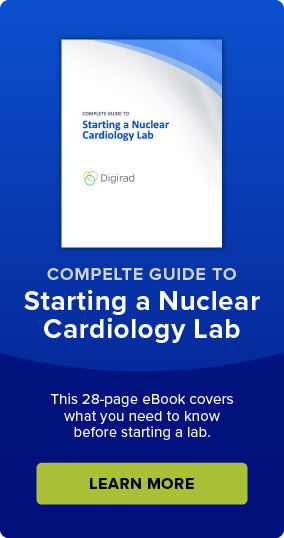Are you an EMT or Paramedicexploring your career options? Here’s something that may not have crossed your radar yet – you can transfer your skills to become a Cardiac Stress Technician (CST) for Digirad!
A career in nuclear cardiology is challenging, yet rewarding. As a CST, you will think on your feet, use your critical care skills, and meet a wide variety of physicians and patients serving a mobile unit. Digirad offers regular hours without 48-hour shifts!
Interested in hearing more? We interviewed Jonathan Flynn, a Cardiac Stress Technician with Digirad, who has more than two decades of experience in the EMS field. Jonathan was hired in 2008 as a Cardiac Stress Technician and is now the Lead CST for the Houston area. He manages cardiac stress testing as well as other operational tasks.
What does a typical day look like for a CST?
The typical day of a Cardiac Stress Technician looks different from an EMT or Paramedic on an ambulance, but there are many shared skills and activities.
“A typical day begins when we show up at the office and get our paperwork and equipment for the day, load up, and drive to get to the client,” Jonathan says. “Once we get there, we unload and set up our equipment. The Nuclear Medicine Technologist sets up the imaging equipment and we also set up the patient preparation area and treadmill.”
“We then start serving the patients, we do a short interview and assessment, where we obtain an H&P, explain the procedure to them, get consent, and get them prepared with an IV line inserted. The nuclear technologist then comes and injects the patient with the radiopharmaceutical for the resting images. The patient will then go to the waiting area and drink water before being called back in for the resting images. Depending on what the physician orders, we will then do either a chemical or physical stress test. We continuously monitor vital signs throughout the test.”
How many patients do they usually see? “Our average day consists of around 12 patients, and we get back to the office between 3 pm and 5 pm. We then get our equipment ready for the next day and go home.”
What’s it like to go from EMS to Nuclear Cardiology?
Jonathan highlights some of the key similarities and benefits of the move to nuclear cardiology:
- Your skillset is transferable. “As far as skills for this job, a lot of your paramedic skills transfer across. I did do a CCT (Certified Cardiographic Technician) course to become qualified for the cardiac side, specifically. I also do a lot of additional learning on the side to keep up with any changes or new technologies and medications coming out,” Jonathan says.
- You still have the independence that you get in an EMS role. “Here, you and your partner run the day,” he says.
- “Every patient and office we work with is different. Days are exciting and varied.”
- You work regular Monday to Friday hours. “When you’re on the ambulance, you’re doing a 24 – 48-hour shift, often constantly moving,” Jonathan says. “You’re exhausted when you get off. Here, I work Monday to Friday and get to spend weekends with my family.”
Broaden your career options
“A lot of paramedics think their only options are the ambulance or the ER,” says Jonathan. “I happened to search a job board and saw a position advertised for a Paramedic in Nuclear Cardiology. I’d never heard of this position before but was drawn to it. Everyone tends to have their thing they’re drawn to and mine is cardiology.”
For Jonathan, it was a great fit. “I look forward to every day that I come to work because it’s always a different office, different atmosphere, and different patients. We develop really good relationships with the physicians and the office. They treat you as part of the family.”
Does he find the role challenging and as interesting as the EMT role? “In this role, you get more of the critical care aspect than you do as a paramedic,” he says. “You really specialize in the cardiology side of things and get to see many conditions frequently that you may only see once or twice as a paramedic.”
What does it take?
Having a background as an EMT or Paramedic helps tremendously. You have to be a team player with critical thinking skills and the ability to react quickly whenever there’s a problem.
“You have to be good at communicating with the patient and really hearing what they’re saying, picking up on the little things,” says Jonathan. “For example, women often don’t have chest pains. We had one patient today and she was experiencing back pain. Her imaging came back positive.”
Paying attention to the details is very important. “What really intrigues me about this is that there are so many different complex pieces – they’re constantly moving,” he says. “We tend to do what we do because we love it and can make a real difference. I can’t tell you the number of times we’ve imaged people and sent them straight to the cath lab upon discovering significant occlusion in the ‘widow maker.’”
Of course, you need top-notch EMS skills in this role. “I get to use a lot of my critical care skills in this work. On top of that, if we have a seriously ill patient who goes into cardiac arrest, I can help them until EMS arrives,” Jonathan says.
What about career advancement?
Jonathan has undergone considerable career advancement since joining Digirad, moving to the role of Lead CST for the Houston area. He appreciates being recognized for his work and having the opportunity to make an impact operationally. He also now has some very specialized nuclear cardiology skills:
“I’m now at a point where I can do everything with that camera except injecting the radioisotope (I lack the qualification to do that),” he says. “Ten years ago, I had a ‘job,’ now I look at this role as a career and where I want to be.”
Final thoughts
“Everything I loved about EMS I have in this role, but I don’t have to work those 48-hour shifts anymore!” Jonathan says. The autonomy and balance that goes with the Cardiac Stress Technician role give him more options with his time.
Importantly, Jonathan enjoys the relationships he cultivates working as part of the Digirad team. “I get to build more of a relationship with patients [than the EMS role] too. We might see the same people over a period of years and really get to know them.”
Interested in joining Digirad? Check out current vacancies on our career page here.




